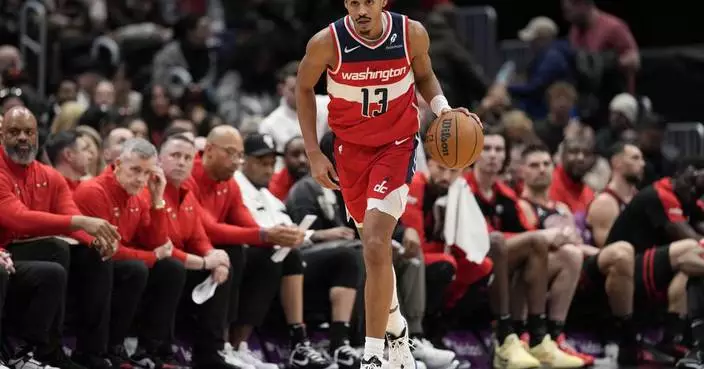DETROIT (AP) — Ford Motor Co. will pay a penalty of up to $165 million to the U.S. government for moving too slowly on a recall and failing to give accurate recall information.
The National Highway Traffic Safety Administration said Thursday that the civil penalty is the second-largest in its 54-year history. Only the fine Takata paid for faulty air bag inflators was higher.
The agency said Ford was too slow to recall vehicles with faulty rearview cameras, and it failed to give the agency complete information, which is required by the Federal Motor Vehicle Safety Act.
Ford agreed to a consent order with the agency that includes a payment of $65 million, and $45 million in spending to comply with the law. Another $55 million will be deferred.
“Timely and accurate recalls are critical to keeping everyone safe on our roads,” NHTSA Deputy Administrator Sophie Shulman said. “When manufacturers fail to prioritize the safety of the American public and meet their obligations under federal law, NHTSA will hold them accountable.”
Under the order, an independent third party will oversee the automaker’s recall performance obligations for at least three years, and Ford has to cooperate with the monitor.
Ford also has to review all recalls over the last three years to make sure enough vehicles have been recalled, and file new recalls if necessary.
The company also must review and change its recall decision-making process, improving the way it analyzes data to find safety defects in its vehicles. It also has to invest in technology so it can trace parts by vehicle identification numbers.
Ford says it will invest the $45 million into advanced data analytics, a new document system, and a new testing lab.
“We appreciate the opportunity to resolve this matter with NHTSA and remain committed to continuously improving safety,” Ford said in a statement.
Under the law, an automaker has to notify NHTSA by filing a defect report within five working days of finding out that a line of vehicles has a safety defect.
The problematic recall of more than 620,000 vehicles in the U.S., over 700,000 in North America, came in September of 2020 for rear-view cameras that can fail on several 2020 models, including the F-Series pickup, the top selling vehicle in the U.S.
In agency documents, NHTSA said Ford found warranty claims about the faulty cameras from February through April of 2020, and the matter was brought to a Ford committee in May of that year.
In July of 2020, NHTSA contacted Ford about complaints it had received about failing cameras, and during an August 2020, meeting with NHTSA, Ford showed data for many 2020 models with high camera failure rates.
The company did the recall on Sept. 23, 2020, and about a year later NHTSA began investigating whether the recall was done quickly enough or included enough vehicles.
In 2022 and 2024, Ford did two more recalls for the same problem, adding about 24,000 vehicles to the first camera recall.
In the consent order, NHTSA said its investigation found that Ford violated multiple parts of the law by moving too slowly to recall vehicles with faulty cameras, giving the agency inaccurate or incomplete information, and failing to turn in required quarterly reports about additional recalls.
The order said that Ford disagreed with its assertions.
For several years, high warranty and recall costs have dinged Ford's profits, but the company says it's working to fix the issues.
The penalty doesn’t end conflicts between Ford and NHTSA.
Earlier this year the agency opened an investigation into a Ford SUV recall repair that doesn’t fix gasoline leaks that can cause engine fires. Investigators wrote in an April 25 letter to Ford that they have “significant safety concerns” about a March 8 recall of nearly 43,000 Bronco Sport and Escape SUVs.
Ford said in documents that fuel injectors can crack, allowing gas or vapor to leak near hot engine parts, potentially causing fires and injuries. But the fix is to add a drain tube to send the gas away from hot surfaces and software that cuts off the fuel supply if it detects a leak.
In the letter, the agency’s Office of Defects Investigation wrote that based on its review of the recall fix, it “believes that the remedy program does not address the root cause of the issue and does not proactively call for the replacement of defective fuel injectors prior to their failure.”
Ford said that it has a strong recall process and is committed to complying with the law, but it can always improve. It said it has learned from the camera recall.
“We look forward to working with NHTSA and the independent third party to implement further enhancements,” Ford said.

FILE - The Ford logo is seen on the grill of a Ford Explorer on display at the Pittsburgh International Auto Show in Pittsburgh, on Feb. 15, 2024. (AP Photo/Gene J. Puskar, File)
LONDON--(BUSINESS WIRE)--Jan 2, 2025--
Cirium, the world’s most trusted source of aviation analytics, today announced the winners of its 2024 On-Time Performance Review, celebrating airlines and airports that excelled in on-time and operational performance.
This press release features multimedia. View the full release here: https://www.businesswire.com/news/home/20250101214982/en/
Cirium’s Annual report is the gold standard for global airline and airport performance analytics. An on-time flight is defined as a flight that arrives within 14:59 minutes of the scheduled gate arrival time. Airports measure punctuality as departing flights within 14:59 minutes of their scheduled departure time.
Mexico’s Flag Carrier Tops Global Rankings
Aeromexico claimed the prestigious title of the most On-Time “Global Airline” in 2024, achieving an impressive On-Time performance rate of 86.70%. Saudia followed closely as the runner-up with 86.35%, while Delta Air Lines secured third place with 83.46%, continuing to showcase its operational reliability on the world stage.
Cirium’s Annual Review also acknowledges the operational excellence of airlines across the world, with five regional awards. Iberia Express, member of the International Airlines Group, had success as both the most On-Time airline in Europe, and the most On-Time Low-Cost airline globally. Japan Airlines ranked first within Asia-Pacific, just slightly ahead of All Nippon Airways.
Delta Air Lines continued its dominance in North America, while Copa Airlines achieved a landmark 10th win in Latin America. Safair’s also won most On-Time airline in the Middle East and Africa. The full tables of results by region and category are presented below.
Riyadh’s King Khalid Airport Takes Top Honors in the Global Airport Category
In the Airport categories, Riyadh King Khalid International Airport, the gateway to Saudi Arabia’s capital, claimed this year’s prestigious title of the most On-Time “Global Airport” with an impressive 86.65% of flights departing on time. The Middle Eastern hub further distinguished itself by securing victory in the ‘Large Airport’ category, outperforming top contenders from around the world.
The title of most On-Time ‘Medium Airport’ was awarded to Panama’s Tocumen International Airport - the home base for Latin American winner Copa Airlines, while the ‘Small Airport’ winner was Guayaquil Jose Joaquin de Olmedo International Airport in Ecuador.
Special Recognition of Operational Excellence: The Cirium Platinum Awards
Delta Air Lines topped the table for a fourth consecutive year, landing Cirium’s Platinum Award for global operational excellence. This prestigious accolade comes as the Atlanta-based airline continues to be praised for its unwavering commitment to operational performance.
The Platinum award considers the complexity of the carrier’s network, volume of flights, and the ability to limit the impact of flight disruptions on passengers over the entire year. The airline was recognized for its on-time performance over the course of 2024 at 83.46%, on more than 1,712,529 total flights in 2024.
This year, Cirium also presented its first annual Platinum Award to a global airport, with El Dorado International Airport in Bogotá, Colombia receiving this prestigious award. The Airport Platinum Award considers a broader range of factors including the impact of delays on passengers, the duration of disruptions, operational complexity, and the airport’s appeal, with a particular focus on growth. This holistic approach highlights excellence across multiple dimensions, setting a new benchmark in airport performance evaluation.
Jeremy Bowen, Cirium CEO, said: “In an industry defined by operational complexity, we are extremely proud to be celebrating the airlines and airports who have provided customers the most on-time flights and best performance in 2024, acknowledging their operational excellence.”
“2024 was a difficult year for airlines, facing a large-scale IT outage, and unseasonable and severe weather patterns. Despite these challenges, these airlines and airports have worked tirelessly to ensure their customers have a smooth journey and reach their destination on-time.”
“We extend our congratulations to all the winners of this year’s On-Time Performance Review, each of whom has set new standards in operational excellence. A special recognition goes to Delta Air Lines for continuing their outstanding winning streak with Cirium’s Platinum Award for airlines, Copa Airlines for achieving its 10th title as Latin America’s most On-Time airline, Iberia Express for its consistent performance as Europe’s most On-Time airline, and Bogotá El Dorado Airport for securing Cirium’s first-ever Platinum Award for an airport.”
Now in its 16th year, the Cirium On-Time Performance Review remains the definitive benchmark for monitoring global airline operational performance. Powered by Cirium’s vast and impartial data—sourced from over 600 real-time feeds, including airlines, airports, global distribution systems, and civil aviation authorities—it offers a thorough and objective view of the industry. The program is further strengthened by the guidance of an independent advisory board composed of seasoned industry experts with decades of experience.
Cirium’s full 2024 On-Time Performance Review is available to view and download at www.cirium.com/on-time-performance.
Notes to editors:
The results for 2024 for the top ten performers in all categories include the following:
Global Airline leaders were:
In Europe the leading airlines were:
In North America the leading airlines were:
In Asia Pacific the leading airlines were:
In Latin America the leading airlines were:
In the Middle East and Africa the leading airlines were:
The leading low-cost carriers were:
Global Airport leaders were:
Large Airports leaders were:
Medium Airports leaders were:
Small Airports leaders were:
About Cirium
Cirium® is the world’s most trusted source of aviation analytics. The company delivers powerful data and cutting-edge analytics to empower a wide spectrum of industry players. Equipping airlines, airports, travel enterprises, aircraft manufacturers, and financial entities with the clarity and intelligence they need to optimize their operations, make informed decisions, and accelerate revenue growth.
Cirium® is part of LexisNexis® Risk Solutions, a RELX business, which provides information-based analytics and decision tools for professional and business customers. The shares of RELX PLC are traded on the London, Amsterdam and New York Stock Exchanges using the following ticker symbols: London: REL; Amsterdam: REN; New York: RELX.
For further information please follow Cirium® on LinkedIn or visit cirium.com.


Cirium On-Time Performance Review 2024 (Photo: Business Wire)











